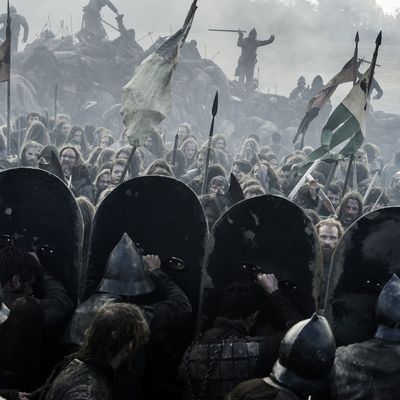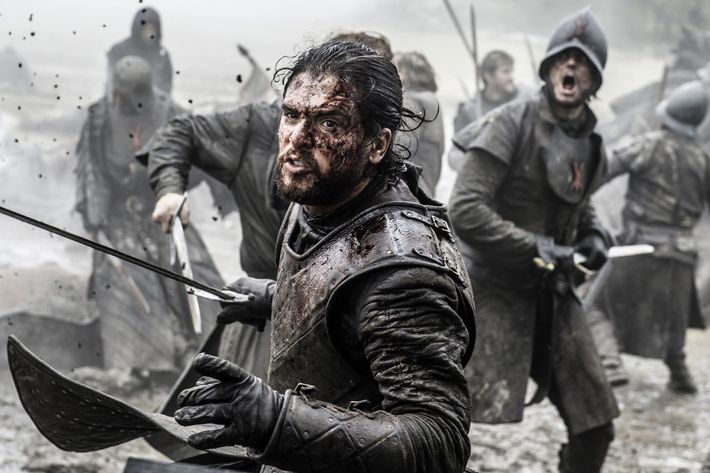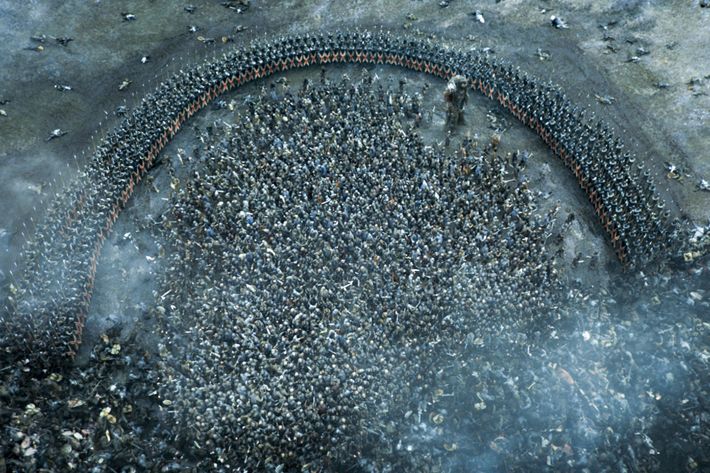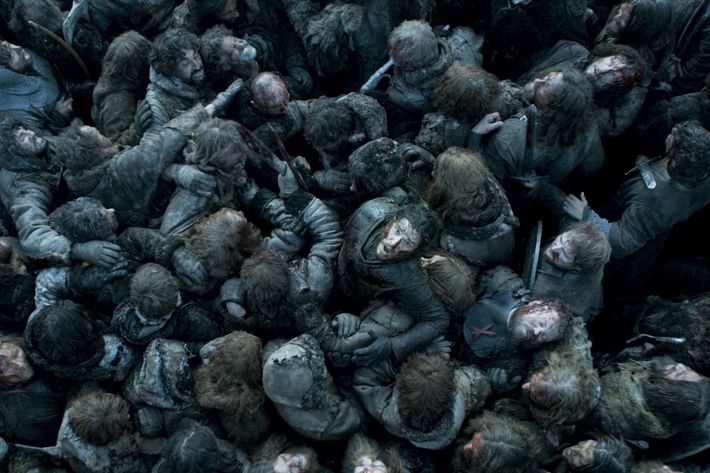
Writing about the historical accuracy of Game of Thrones is a tricky thing: The real medieval era didn’t have dragons flying around, and real castles never had to face the threat of an angry giant punching their gates in. But Sunday night’s “Battle of the Bastards” was such a visceral, gut-punch affair that we couldn’t help but wonder how true it was to the realities of warfare in the Middle Ages. So we got in touch with BryndenBFish, a Song of Ice and Fire expert who writes about the military aspect of the series over at Wars and Politics of Ice and Fire. (In real life his name is Jeff, and he’s a captain in the Army.) The intent is less to dock realism points from the show — there was a giant there, after all — than to give a primer on the basics of medieval warfare, and how they may have differed from what we saw onscreen.
At Jon’s war council, we get a glimpse of his initial strategy: Keep archers in the back, protect them with trenches in the flanks, and bait Ramsay into attacking. Knowing what we know about the two armies, is that a good plan?
Yeah. Jon’s plan is similar to how the English attempted to fight the battle of Agincourt, which was to force the French to come to them in a place with disadvantageous terrain. Putting trenches along the flanks mitigates Ramsay’s advantage of superior cavalry. It also forces what you would call a local force majority: Instead of a wide-open area where Jon would have to spread his army out in order to meet the different places where Ramsay could attack, he was able to concentrate his forces in one location. It was a good plan to start, for sure.
And then he had to go and ruin it by charging after Rickon by himself. If Jon was not the hero in a fantasy series, what are the odds he would have survived that?
Zero. [Laughs.] Medieval battle wasn’t fought with one heroic man running around. It was fought in units. You would literally march shoulder-to-shoulder with every single person going with you. And that unity provides a means for you to use the person to your right, left, front, and behind to defend yourself. If you have someone attacking you from your left, you’ve got someone on your left, and so on. Jon attacking by himself on the battlefield was basically suicidal.

Once the battle got started, we saw Ramsay ordering his archers to shoot into the melee, with little regard for the safety of his own troops. Did this happen often in medieval battles, or was it a character move to illustrate that Ramsay is exceptionally ruthless?
It was a character move for Ramsay. You have to consider the feudal system that Westeros is based off. Ramsay has a number of Northern lords that have sworn their service and their swords to him. If he had sent these guys out in the middle of the battlefield and then rained down arrows at them, he’s basically saying, I don’t really give a damn about your contribution to my effort. And that breaks the feudal code. The Umber lords would have been like, Whoa, why would I send my men out to the middle of this battlefield if you’re just going to kill my guys anyway?
But in the book Game of Thrones, Roose Bolton is in the battle on the Green Fork, fighting Tywin Lannister. [This is the battle where Tyrion got knocked out in the show.] There’s a part of the battle when Tyrion is out in the middle of the battlefield and all of a sudden a bunch of arrows start raining down. Tyrion doesn’t know where the arrows are coming from, but there’s thematic and narrative evidence that it’s Roose Bolton who’s loosing the arrows on the battlefield. At that point in the story, Roose is looking to weaken the houses that have lands surrounding Bolton lands. He holds his own bannermen in reserve, so he’s only killing people he wants to seize lands from. There is a mirroring effect there, if the show was going for that motif.
Later, Davos send his own archers in to fight hand-to-hand. Was that sound strategy?
In movies we look at archers and they’re just picking out masses and masses of dudes. They did have that impact, but their greater impact was to disrupt the cohesiveness of an enemy unit moving forward. If you think about what I was saying before, you have a unit with guys to your right and your left — if you have archers firing at you as you’re moving forward, suddenly you don’t have a guy to your right or your left. It breaks up your cohesiveness, so when your infantry unit hits another unit, you might not be as deadly if you’ve taken a number of casualties coming across the open field. Davos rushing his archers in at that point is not a terrible tactic because he rightly didn’t use them to fire into the massive crowd at the middle of the battlefield, but at the same time it did mitigate their intended effective purpose.
In the middle of the melee we get that great tracking shot, where it’s just chaos all around Jon. It feels very realistic, but is it actually?
It was a bit more controlled by that. One of the things that got lost at the battle was that Jon was the commander of the overall forces, but you don’t see him giving a single order. He doesn’t have any impact on the direction and the movement of soldiers, he just becomes a combatant. Most of the time — not 100 percent of time — commanders in those types of settings wouldn’t put themselves in the middle of the battle to fight. They had the responsibility of organizing and directing different elements. You do have examples in history of characters like Alexander the Great and Julius Caesar who led from the front. But the thing that Alexander had, and Julius Caesar to a lesser extent, was trusted subordinates and a well-established plan. Jon doesn’t necessarily have the same thing.

We saw Ramsay’s spearmen surround Jon and the Wildlings and crush them from all sides. Is that based on anything real?
It actually is. It’s based on the battle of Cannae from the Second Punic War that was fought in 216 B.C. Hannibal invades Italy, and the Romans were able to raise about 80,000 soldiers. Hannibal didn’t have the numbers that the Romans did, so at the battle, the Carthaginians took their lines into a U-shape. The Romans started punching through the Cathiginian line, but the problem with that was, they attacked up to the middle part of that U. The Carthaginians constricted their own lines and they closed the gap all the way around, and they killed something like 60,000 men in a day. So it’s actually historical. The mountain of bodies blocking Jon and the Wildlings is more cinematic, but the actual tactics Ramsay used are pretty solid.
Jon almost got trampled to death in the crush of battle. How much of a danger was that for a medieval soldier?
At the battle of Agincourt, the French took thousands of casualties before they reached the main English line. There are contemporary accounts from the battle of French soldiers dying because they’ve suffocated when mud went through their visor, and they couldn’t get up. A lot of the French and English historians who were at the battlefield itself mentioned how horrific it was that all these men drowned to death in mud, and were trampled by their fellow soldiers. The show emphasized that claustrophobic feeling for Jon.

This was the third big battle episode on Game of Thrones that climaxed with a surprise cavalry charge. How often did that happen in real life?
I think George R.R. Martin himself, when he was doing his battles, was basing them more off the Lord of the Rings series, especially the charge at Pelennor Fields. That kind of hammer-and-anvil thing where you have cavalry rotating around didn’t happen as much in real life — a good commander is going to have cavalry in the wings and a reserve of soldiers in the rear to prevent something like that from happening.
Finally, after the episode aired, a lot of people were criticizing the way Rickon ran away from Ramsay’s arrows, saying he would have lived if he had zigzagged. That’s crazy, right?
Right. People were like, “Serpentine, serpentine!” In Generation Kill, there’s a part where the Marines are taking sniper fire, and all the Marines run in a straight line as fast as they can. They have a reporter with them from Rolling Stone doing a serpentine back and forth, and the Marines just look at him like, What the fuck are you doing, man? Because if you’re running in a straight line, you’re able to run away from the person shooting at you faster. And Rickon’s just a kid: He’s terrified, he’s been a captive of Ramsay for several months. You’re not thinking tactically. I don’t think that’s a big issue for the show writers.
This interview has been edited and condensed.





